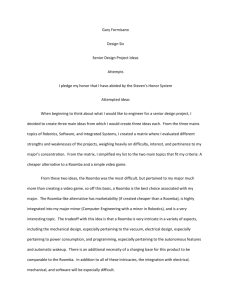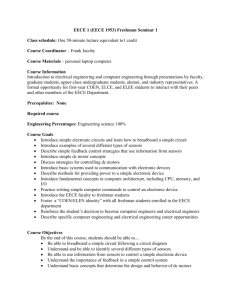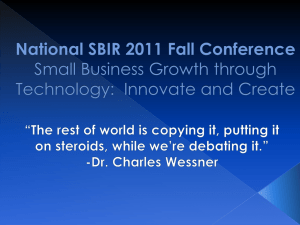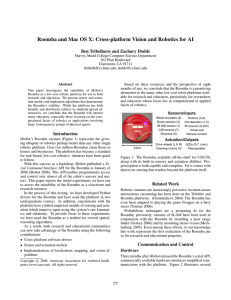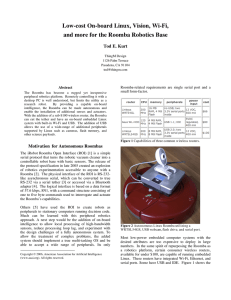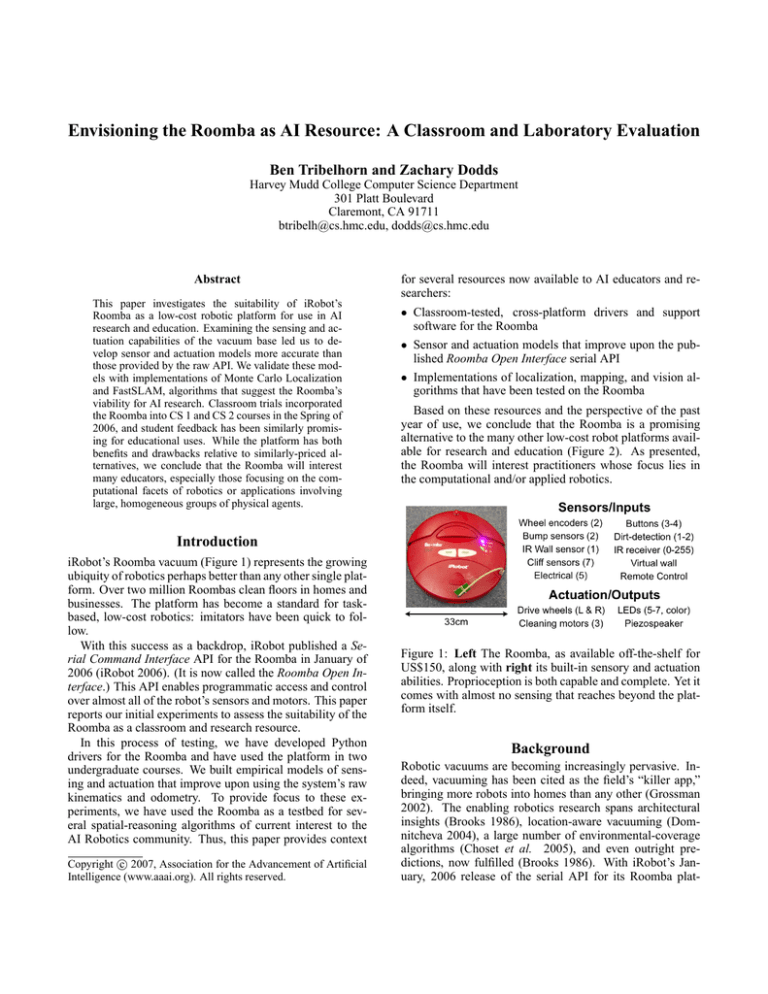
Envisioning the Roomba as AI Resource: A Classroom and Laboratory Evaluation
Ben Tribelhorn and Zachary Dodds
Harvey Mudd College Computer Science Department
301 Platt Boulevard
Claremont, CA 91711
btribelh@cs.hmc.edu, dodds@cs.hmc.edu
Abstract
This paper investigates the suitability of iRobot’s
Roomba as a low-cost robotic platform for use in AI
research and education. Examining the sensing and actuation capabilities of the vacuum base led us to develop sensor and actuation models more accurate than
those provided by the raw API. We validate these models with implementations of Monte Carlo Localization
and FastSLAM, algorithms that suggest the Roomba’s
viability for AI research. Classroom trials incorporated
the Roomba into CS 1 and CS 2 courses in the Spring of
2006, and student feedback has been similarly promising for educational uses. While the platform has both
benefits and drawbacks relative to similarly-priced alternatives, we conclude that the Roomba will interest
many educators, especially those focusing on the computational facets of robotics or applications involving
large, homogeneous groups of physical agents.
for several resources now available to AI educators and researchers:
• Classroom-tested, cross-platform drivers and support
software for the Roomba
• Sensor and actuation models that improve upon the published Roomba Open Interface serial API
• Implementations of localization, mapping, and vision algorithms that have been tested on the Roomba
Based on these resources and the perspective of the past
year of use, we conclude that the Roomba is a promising
alternative to the many other low-cost robot platforms available for research and education (Figure 2). As presented,
the Roomba will interest practitioners whose focus lies in
the computational and/or applied robotics.
Introduction
iRobot’s Roomba vacuum (Figure 1) represents the growing
ubiquity of robotics perhaps better than any other single platform. Over two million Roombas clean floors in homes and
businesses. The platform has become a standard for taskbased, low-cost robotics: imitators have been quick to follow.
With this success as a backdrop, iRobot published a Serial Command Interface API for the Roomba in January of
2006 (iRobot 2006). (It is now called the Roomba Open Interface.) This API enables programmatic access and control
over almost all of the robot’s sensors and motors. This paper
reports our initial experiments to assess the suitability of the
Roomba as a classroom and research resource.
In this process of testing, we have developed Python
drivers for the Roomba and have used the platform in two
undergraduate courses. We built empirical models of sensing and actuation that improve upon using the system’s raw
kinematics and odometry. To provide focus to these experiments, we have used the Roomba as a testbed for several spatial-reasoning algorithms of current interest to the
AI Robotics community. Thus, this paper provides context
c 2007, Association for the Advancement of Artificial
Copyright Intelligence (www.aaai.org). All rights reserved.
Figure 1: Left The Roomba, as available off-the-shelf for
US$150, along with right its built-in sensory and actuation
abilities. Proprioception is both capable and complete. Yet it
comes with almost no sensing that reaches beyond the platform itself.
Background
Robotic vacuums are becoming increasingly pervasive. Indeed, vacuuming has been cited as the field’s “killer app,”
bringing more robots into homes than any other (Grossman
2002). The enabling robotics research spans architectural
insights (Brooks 1986), location-aware vacuuming (Domnitcheva 2004), a large number of environmental-coverage
algorithms (Choset et al. 2005), and even outright predictions, now fulfilled (Brooks 1986). With iRobot’s January, 2006 release of the serial API for its Roomba plat-
Platform
Lego RCX
Roomba
Lego NXT
Intellibrain
PalmPRK
HandyBoard
KIPR XBC
UMN eRosi
HandyBoard2
Hemisson
Garcia
Khepera
AIBO
Cost
$200
$230
$250
$300
$325
$350
$500
$500
$750
$780
$1725
$2000
$2000
Sensing
Bmp,Lt
Bmp,Enc,Vis,Mic,WL
Bmp,Lt,Son,Enc,WL
Bmp,Lt,IR,a2d,WL
IR,a2d
Bmp,Lt,IR,a2d
Vis,Bmp,Lt,IR,Enc
Lt,Enc,Pyr,WL
Vis,Bmp,Lt,IR,Enc,a2d,WL
Lt,IR,WL
Vis,IR,Enc,WL
IR,Enc
Vis,Mic,Bmp,Enc,WL
Whimsical applications have emerged: the Roomba has
been adapted to playing the game Frogger on a busy street
(Torrone 2006). But it is not obvious that the Roomba
can serve as a resource for validating AI researchers’ algorithms or enabling students to implement and experiment
with those algorithms in a lab setting. To our knowledge,
this paper is the first to address these questions.
Communication Performance
Drivers
Figure 2: A comparison of several inexpensive robot platforms/controllers, their costs, and their standard set of sensing capabilities. Legend: Bmp, bump or tactile sensing;
Lt, light sensing; Vis, vision; Mic, microphone; Enc, encoders or odometry; WL, wireless communication with a
controlling PC; a2d, general analog/digital inputs; IR, infrared range sensing; Pyr, heat or flame sensing. The vision
(and microphone) sensors on the Roomba are available from
an onboard laptop computer, e.g., as in Figure 10.
form (iRobot 2006), there is now an opportunity for robotics
researchers and educators to benefit from the successes of
the home-robot industry.
This API makes any Roomba an ordinary serial device, though vacuums assembled before 10/2005 require a
firmware upgrade. The API specifies a byte-level protocol; this protocol has been incorporated into software drivers
written in Java (Kurt 2006), C++ (within Player/Stage)
(Gerkey 2006), and Python (Dodds & Tribelhorn 2006b).
Even before the release of the API, the worldwide community of robot enthusiasts had shown the platform’s promise
(Gerkey 2006) (Mecklenburg 2005). More recently, Bluetooth, USB, and RS232 serial interfaces have become commercially available (RoombaDevTools 2006). Figure 3 summarizes these devices and their current costs.
Figure 4: The architecture of our Python-based software
driver for the Roomba platform.
To test our Roombas we have written two Python layers atop iRobot’s byte-level serial command interface (now
known as the roomba open interface). The lower layer provides full access to the Roomba’s sensors, speaker, motors,
and built-in behaviors. Our upper layer allows for straightline translation (oddly, not part of iRobot’s provided API),
and it includes our odometric correction model described in
the following section. Figure 4 summarizes the software architecture; the code itself is freely available from (Dodds &
Tribelhorn 2006a).
Bluetooth
Figure 3: Commercially available USB, RS232, and Bluetooth serial interfaces to the Roomba provide researchers
and educators an inexpensive platform that requires no custom hardware or construction at all. When obtained with a
$150 Roomba, these devices are US$10, $5, and $80, respectively (RoombaDevTools 2006).
With iRobot-based software support and third-party hardware interfaces, off-the-shelf Roombas are now programmatically accessible without any modification whatsoever.
The most flexible method of communication is Bluetooth,
which uses the unlicensed 2.4 GHz ISM (Industrial Scientific Medical) band. Figure 3’s Bluetooth device, nicknamed
the RooTooth is Class 1, allowing a range of up to 100 meters. Connection quality over distance drops slowly and our
tests indicate that adequate connections can be made at up
to 200ft. In theory, the number of Bluetooth devices that
can be used simultaneously is large, as there are 79 channels
available. Our tests have demonstrated that a single laptop
can easily interact with multiple devices; we tested 5 concurrently in a small, confined space without interferences or
reduction in throughput to the individual Roombas.
Throughput
USB polling of the Roomba’s full suite of sensors averages a
throughput around 66 hz; Bluetooth is considerably slower.
A single RooTooth will only peak at 16 hz in Fast Data Mode
and 6 hz in its normal mode. Thus despite the additional
setup effort, an onboard laptop not only can provide a significant boost to a Roomba’s sensing capabilities, it enables
more effective use of existing sensors because of the considerably faster polling rate.
production run are quite consistent in their behavior. However, those from different production runs can be very different in their responses to identical API actuation commands
under identical environmental conditions.
Odometry
Simulation
Building atop our python drivers, James Snow has created an interface to the Roomba available within the
Python Robotics (Pyro) toolset (Snow & Fossum 2007).
Player/stage support is also available (Gerkey 2006). Although both of these resources provide a capable and sophisticated interface to all of the hardware platforms they
support, we used a simple, homegrown simulator for the
Roomba as a testbed for our algorithm implementations.
This pure-Python, 2d visualizer (depicted in Figure 9 and at
right in Figures 8 and 11) can emulate the platform’s sensing and is packaged with the drivers at (Dodds & Tribelhorn
2006a).
Figure 6: Comparison of basic kinematic odometry,
velocity-integrated odometry, and our modeled odometry on
18 runs of two robots from separate manufacturing batches.
Roombas do provide odometry. Unfortunately, there is
a huge bias in translating left and right turning around the
maximum radius of curvature (ROC), e.g., between −30◦
and 80◦ over 15s at 20cm/s. Our RoombaDrive software
layer compensates for this lean by time-slicing left and right
turns at the maximum ROC. Denoting this time-slicing parameter α, the resulting odometric models map from raw
angle and distance, available from the API, to actual angle
θ and distance r (in cm) as follows:
Figure 5: Upper left The central robot shows the starting
position for all three runs, each heading straight towards the
viewer Lower left The final position after the straightestpossible run with right-hand bias Lower right The result
of the same command with left-hand bias Upper right The
final position after 3 meters of straight-line translation using
the odometric model presented in this section.
Modeling the Roomba
A small number of discrepancies between the Roomba’s
published programming interface and the platform’s behavior motivated our own modeling of its actions and accuracy. For instance, the API cites special codes to indicate
straight-line driving (iRobot 2006, p. 4). However, as Figure 5 attests, actual behavior did not differ from those commands’ large radius of curvature (ROC) limits, published at
two meters. Discussions among many experimenters have
confirmed the difficulty of straight-line motion through the
API alone. Second, we found that Roombas within a single
r=
distance
∗ (0.705 + α − α2 ) − 5
10.0
(1)
angle
∗ (0.705 + α − α2 )
129.0
(2)
θ=
These models are derived in detail in (Tribelhorn & Dodds
2007). In essence, the 5cm represents constant slippage and
the constrained quadratic factor represents a compensation
for the lean of each individual robot, α. Figures 6 and 7
demonstrate the improvement of this model over velocity
integration and the API’s unmodified odometric feedback.
Local Sensing
The Roomba comes solely with local sensing in the form of
bump and IR sensors. The bump sensors have four states
which result from a left and right sensor attached to a rigid
bumper. These states are left, right, front, or no bump. The
collision angle that will produce a front bump varies with
the sampling rate. For an ideal situation, bumps within the
cone of ±20◦ cause both sensors to trigger (due to bumper
rigidity). However at sampling rates of around 4Hz or less,
Figure 7: Here raw odometry demonstrates noticeable skew
(21.5%) in comparison to our modeled, adjusted odometry.
a front bump will be detected at a range of ±60◦ or more.
If the response to this bump is similarly slow, the robot
will usually slip and actually end its motion facing the wall
which can adversely effect odometry. Our modeled odometry lessens, but does not eliminate, this effect.
Algorithmic Validation: MCL and FastSLAM
Monte Carlo Localization (MCL) is a probabilistic estimation of pose in which Bayesian updates combine uncertain
sensing and odometric information (Thrun et al. 2001). Using only the Roomba’s local sensing (tactile and odometric),
we implemented and demonstrated successful MCL pose
tracking at AAAI 2006. An example of one such run is
shown in Figure 8.
Both our AAAI and lab runs used a 35% uniform-error
model in distance and 25% in angle to compensate for the
inaccuracy of the naive kinematic model on which it relied.
These large uniform errors were necessary to create sufficiently robust particle coverage for MCL in these two environments. The relatively large (and computationally expensive) population of 300 particles was needed to successfully localize the Roomba. This demonstrates the substantial
advantage of using off-board computation: the onboard microcontrollers that support smaller low-cost platforms would
struggle to hold and update this population in real time.
Adding Vision
In order to tackle mapping (more precisely, simultaneous localization and mapping), most algorithms of current interest
rely on richer sensing than the Roomba provides out-of-thebox. We chose to mount a laptop on the Roomba with velcro
Figure 8: Recorded at AAAI 2006, this shows a Roomba
successfully localizing itself using MCL. In the middle image note that the wall in question is actually a virtual wall,
encountered as an observer paused to watch the action.
to attain enough onboard processing for vision. This setup
with Apple’s iSight camera can be seen in Figure 10.
We discovered that the iSight provides pixels natively in
YUV 4:2:2 colorspace, a lossy encoding of RGB data. The
YUV data width provided is 16 bits: a pair of UY or VY
bytes alternately for each pixel. This loss in color information is generally undetectable by the human eye because
our eyes are more sensitive to the luminance (Y) than differences in color (UV). Initially we converted the YUV values
to RGB, but color segmentation does not improve with RGB
thresholding. To save on computation we reverted to using
the raw YUV values.
Using Mac OS X as this project’s primary development
environment, we have devloped a C library that enables access to the pixel values provided by the iSight camera (or
any other QuickTime input). These drivers are available
from (Dodds & Tribelhorn 2006a). To our knowledge there
is prior work in this area, but it has not allowed for pixellevel access to image streams, e.g., (Heckenberg 2003).
Atop these low-level routines, a set of vision algorithms
find the largest connected components segmented by color
and calculates a set of shape statistics on that object which
are used for classification. For example, segmentation on
“red,” suitably defined, will match a teddy bear’s clothing
or a piece of construction paper. Figure 10 summarizes the
visual statistics computed.
Figure 9: An MCL run in another environment (a “maze”
in our lab). The most probable pose (the small blue circle among the 99 other less likely hypotheses) was indistinguishable from the ground-truth pose, while the odometric
estimate (the large red circle) resulted in a location far from
the actual robot.
FastSLAM
With visual input now available, we implemented FastSLAM 1.0 with known data correspondence as detailed
in Probabilistic Robotics (Thrun, Burgard, & Fox 2005).1
FastSLAM uses a point-feature tracker, so vision is a natural fit. We created visual landmarks by placing construction paper on the walls as seen in Figure 11. In a joysticked
run of the robot, the vision system correctly identified and
plotted the poses and uncertainties of the four landmarks as
shown in Figure 11. The loop closure that occurs when the
red landmark is seen for a second time significantly reduces
that feature’s pose uncertainty.
Bump-only Roomba Mapping
Mapping without vision on the Roomba presents a stiff challenge because of the platform’s lack of built-in range sensing. We have designed a preliminary set of mapping algorithms using only local bump sensing and odometry. To
compensate for this impoverished sensory data, we assume
strong prior knowledge about the environment:
• that it consists only of straight-line walls.
• that all of those wall segments are either parallel or perpendicular.
These assumptions allow several interpretations of the incoming data, e.g., line fitting to raw odometry of the bumps.
Our results from this algorithm and other variants are presented in (Tribelhorn & Dodds 2007).
Educational Trials
The Roomba was used as the basis for several assignments
in a CS1/CS2 course sequence taught at Chatham College,
1
Five notational/typographical errors were identified in this version of the algorithm; these have been reported to the book’s authors and website.
Shape Statistic
best ellipse angle
major axis length
minor axis length
Value
23.1◦
76.5
45.5
Shape Statistic
pixel count (area)
roundness
color label
Value
1918
0.42
“red”
Figure 10: Top left Mounting a laptop and the iSight on
the Roomba Top right The largest connected component
defined as “red” is highlighted in blue. Smaller red components are green. Bottom The shape statistics computed
for that largest connected component.
an all-women’s institution in Pittsburgh, PA. Low cost was
one reason for choosing the Roomba. The more compelling
reason, however, was that the Roomba, as a simple serial
peripheral, integrated effortlessly into the environment in
which these courses were already being taught.
This CS1/CS2 trial included an external assessment effort
to determine the extent to which the Roomba (and robots in
general) affected students’ feelings and capabilities in learning introductory computer science. The results have shown
that the physical interactions had a significant impact. One
student indicated that the impact was intellectual:
Like when you’re just working on the screen it’s like
‘oh the little dot is moving.’ When you’re working with
the actual thing [the Roomba], you’re like okay, problem solving. Because it’s a lot easier to solve the problem if it’s 3D, in front of you, and you can see exactly
what the problem is.
Another student described the robot’s impact in affective
terms: “Playing with the Roomba made it a lot more fun.”
A third student pointed to overcoming some of the
Roomba’s idiosyncracies when asked Which activities do
you think have been most useful this semester in making you
a better programmer?:
I would say that probably working with the Roomba
definitely just because the first day we worked with it
we were trying to get it to go in a straight line because
it has like a natural curve to it so it doesn’t go straight.
Overall, the Roomba added excitement to the classes, and
it provided hands-on, task-specific applications for the programming concepts covered. Moreover, the Roomba did not
advent of robotic peripherals that can take advantage of all
of the computing power and cost-efficiency of today’s commodity laptop and desktop machines. This paper provides an
improved odometric model of the Roomba, some strategies
for handling its idiosyncrasies, and and an initial assessment
of the Roomba’s capabilities. We believe it won’t be long
before there emerge a wide variety of applications of this
modest platform.
Acknowledgments
Figure 11: Left Five landmarks, distinguished by color,
placed along a hallway. Only four were used. The segmentation of the red landmark appears on the monitor; the
robot is in the location of its second sighting of that red landmark, an event which “closes the loop,” reducing the uncertainty in the potential location of that map feature. Right
A closed-loop run of vision-based FastSLAM. Note that the
ellipses themselves, representing the pose uncertainty of the
similarly-colored landmarks, are the most-likely computed
map. FastSLAM maintains many such maps in a particle
filter, each with a distinct odometric run, here shown as the
diamond-shaped quadrilateral. The thin vertical black lines
are not used in the computation; they are the “real” map, superimposed for comparison. In this case, color was used to
provide the correspondence between different sightings of
the individual landmarks.
add the time-intensive overhead of constructing and maintaining Lego-based or other hand-built platforms, nor did it
require us to change the programming language or OS on
which the class was based. In contrast to many of the other
platforms in Figure 12, the Roomba can be used to support
an existing CS and AI curriculum, rather than requiring a
curriculum designed especially for it.
Perspective
These extensions and applications of the Roomba only
scratch the surface of what is possible, enabling users an
inexpensive basis on which to design systems that run “with
our initiation, but without our intervention.” (Brooks 1986)
As this paper demonstrates, even the ubiquitous, unmodified
Roomba platform can support far more than the vacuuming
tasks for which it was designed. As an educational resource,
the Roomba is pedagogically scalable: it is as suitable for
reinforcing beginning programming concepts as it is for exploring algorithms of current interest to the robotics community. As a research resource, the Roomba empowers investigators who want to use robots, rather than build them. For
example, it offers researchers involved in the fields of multiagent systems, HRI, or many other subfields of AI and CS an
off-the-shelf means to embody and test their work without
having to spend time constructing or modifying hardware.
Ultimately, the Roomba offers the robotics community
both an example of the widespread commercial viability of
autonomous robots and a novel resource we can leverage
toward our educational and research goals. It heralds the
This work was made possible by funds from NSF DUE
#0536173, as well as funding and resources from Harvey
Mudd and Chatham Colleges.
References
Brooks, R. 1986. Achieving Artificial Intelligence through Building Robots. Technical report, Massachusetts Institute of Technology, Cambridge, MA, AI-Memo 899.
Choset, H.; Lynch, K.; Hutchinson, S.; Kantor, G.; Burgard, W.;
Kavraki, L.; and Thrun, S. 2005. Principles of Robot Motion:
Theory, Algorithms, and Implementations. MIT Press.
Dodds, Z., and Tribelhorn, B.
2006a.
Erdos.
http://www.cs.hmc.edu/∼dodds/erdos.
Dodds, Z., and Tribelhorn, B. 2006b. Erdos: Cost effective peripheral robotics for AI education. In Proceedings, 2006 AAAI,
pp. 1966–1967.
Domnitcheva, S. 2004. Smart vacuum cleaner - an autonomous
location-aware cleaning device.
Gerkey, B.
2006.
Mapping with the iRobot Roomba.
http://www.ai.sri.com/∼gerkey/roomba/index.html.
Grossman, L. 2002. Maid to order. Time Magazine September.
Heckenberg, D. 2003. Using Mac OS X for Real-Time Image
Processing. In Proceedings of the Apple University Consortium
Conference.
2006. Roomba SCI specification. www.irobot.com/hacker.
Kurt, T. 2006. Hacking Roomba: ExtremeTech. Wiley. to appear.
Mecklenburg,
P.
2005.
Roomba SLAM.
http://www.cs.unc.edu/∼prm/roomba/roomba-slam.pdf.
2006. RoombaDevTools. www.roombadevtools.com.
Snow, J., and Fossum, T. 2007. How platform-independent is
pyro? In Proceedings, AAAI 2007 Spring Symposium, “Robots
and Robotics: Resources for AI Education”, (to appear).
Thrun, S.; Fox, D.; Burgard, W.; and Dellaert, F. 2001. Robust
monte carlo localization for mobile robots. Artificial Intelligence
128(1-2):99–141.
Thrun, S.; Burgard, W.; and Fox, D. 2005. Probabilistic Robotics.
MIT Press.
Torrone, P. 2006. Roomba Tronic. Make Magazine Volume 06:
Robots.
Tribelhorn, B., and Dodds, Z. 2007. Evaluating the Roomba: A
low-cost, ubiquitous platform for robotics research and education.
In Proceedings of the International Conference on Robotics and
Automation, (to appear).

